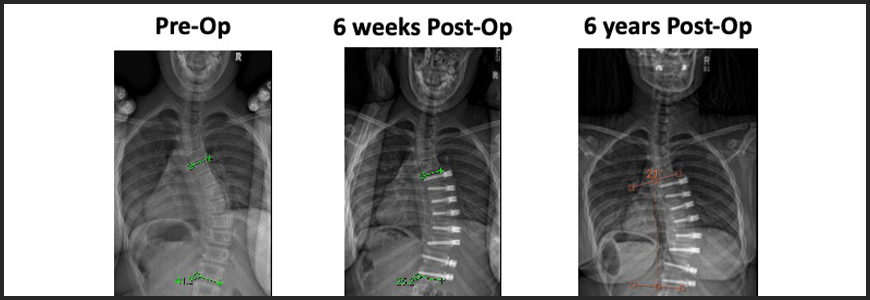A 6-year-old female patient was referred to Duke by her local pediatrician after her mother noticed a possible abnormality in her spine. Duke pediatric orthopaedic surgeon Robert K. Lark, MD, MS, diagnosed idiopathic scoliosis. Lark recommended a brace as the first line of treatment, but the curvature of the patient’s spine did not improve.
The next standard, traditional treatment would have been a spinal fusion procedure, which can alleviate the curvature but significantly restricts the patient’s range of motion.
What innovative surgical solution did Dr. Lark offer to preserve flexibility in the patient’s spine?
The patient was presented with a novel surgical technique—vertebral body tethering as a corrective for scoliosis. She became the first patient in North Carolina to undergo the procedure in 2017.
In this procedure, the surgeon uses screws to attach a flexible polypropylene cord to the vertebrae on the outside of the curve. The tether is tightened so it pulls against the curve, which encourages vertebral growth on the inside of the curve and allows the maturing spine to grow out of the scoliosis.
The procedure is much less invasive and has a faster recovery time than spinal fusion. It avoids fusion’s limits on growth and motion, and leaves the spine free to move more naturally.
The tether remains in the body indefinitely. It may tear over time, but it is no longer needed once the patient reaches maturity.
To be candidates for tethering, patients need to have enough development remaining to grow out of the scoliosis, but not too much because the spine can grow into a problem in the opposite direction. The curvature needs to be large enough to benefit from surgery but not too great. “The tether is not strong enough to handle a super-big curve,” Lark says. “We typically don’t tether anything over 60 degrees. The sweet spot is a curve of 40 to 60 degrees.”
At 12 years old, with a curvature of just over 40 degrees, the patient was a good fit, Lark says. She was back in school less than a month after surgery and soon returned to her active life of playing volleyball. Five years post-surgery, she has a curve of 20 degrees and no physical limitations from her scoliosis or treatment. “If your curve stays under about 35 degrees, you can lead an active, healthy life,” Lark says.
